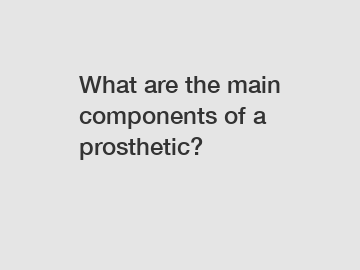What are the main components of a prosthetic?
Prosthetics have been a crucial part of healthcare for individuals who have lost limbs due to accidents, illnesses, or birth defects. These artificial devices aim to provide function and mobility to those who have experienced limb loss. While prosthetics come in various sizes and designs, all prosthetic devices are made up of key components that enable them to mimic the actions of natural limbs. In this article, we will explore the main components of a prosthetic and discuss their individual roles in providing support and mobility to the user.
**Socket**.
The socket is the part of the prosthetic that attaches to the residual limb of the user. It is custom-made to fit the unique shape and size of the residual limb, providing a secure and comfortable connection between the limb and the prosthetic device. The socket is typically made of durable material such as carbon fiber, thermoplastics, or fiberglass, which can withstand the weight and pressure exerted on it during daily activities.

**Liner**.
The liner is a cushioning layer that is placed inside the socket to protect the residual limb from friction and pressure. It helps to distribute the weight of the user's body evenly across the residual limb, reducing the risk of discomfort or skin irritation. Liners are typically made of silicone or other soft materials that provide both comfort and support to the residual limb.
**Suspension System**.
The suspension system is responsible for holding the prosthetic device in place during movement. It prevents the prosthetic from slipping or shifting while the user is walking, running, or engaging in other activities. There are various types of suspension systems, including suction sockets, pin systems, and strap-and-buckle systems, each offering different levels of security and comfort to the user.
**Knee or Elbow Joint**.
For prosthetic devices designed for above-the-knee or above-the-elbow amputations, a knee or elbow joint is an essential component. These joints enable the prosthetic limb to bend and move in a manner similar to natural joints, allowing the user to perform everyday tasks with greater ease and flexibility. Knee and elbow joints come in different designs, including mechanical, hydraulic, and microprocessor-controlled components, each offering specific advantages based on the user's needs and activity level.
**Foot or Hand**.
The foot or hand component of a prosthetic device is responsible for providing stability, balance, and grip to the user. Prosthetic feet are designed to absorb shock and mimic the natural movement of the foot during walking or running, while prosthetic hands are equipped with fingers or hooks that can grasp and manipulate objects. The type of foot or hand component used in a prosthetic device depends on the user's mobility requirements and lifestyle preferences.
**Closing Paragraph**.
In conclusion, prosthetic devices are complex systems that consist of several key components working together to provide support, mobility, and functionality to individuals who have lost limbs. Each component plays a crucial role in ensuring the comfort, security, and usability of the prosthetic device for the user. By understanding the main components of a prosthetic, healthcare professionals can design and customize prosthetic devices that meet the unique needs and preferences of each individual. If you have any questions about prosthetic components or would like to learn more about prosthetic devices, please do not hesitate to contact us.
**Contact Us**.
For more information on prosthetic components, feel free to reach out to us at any time.
Want more information on wonderful prosthetic & orthotic rehabitation, waterproof and non-slip sach foot factory, low ankle carbon fiber foot supplier? Feel free to contact us.


